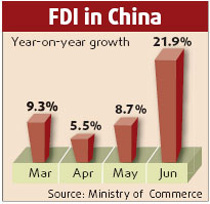China has registered a solid growth track since 2003, and its economy has expanded quickly and in a stable manner, the National Bureau of Statistics (NBS) said yesterday.
Living standards have also improved considerably, as income levels have steadily increased since the 16th National Congress of the Communist Party of China convened in 2002, according to the NBS.
The economy expanded by more than 10 percent in each of the last four years, at an average of 10.4 percent. That is more than double the average growth rate of the world economy during the same period, and is higher than any period in China since reform and opening-up in the late 1970s.
The economy remained stable as it steamed ahead. In the last four years, the growth rate never fluctuated by more than 1.1 percentage points. Meanwhile, consumer prices have also remained stable at about 2.1 percent per year.
China's overall economic volume was the world's fourth largest in 2005. It was the sixth largest in 2002. The gap between China and the US, Japan and Germany - the top three world economies - has also narrowed in terms of gross domestic product (GDP).
As its economy has grown, China now contributes more than 5.5 percent of the world's GDP, up from 4.4 percent in 2002.
China's booming economy also saw its per capita income cross the threshold of $2,000 for the first time in 2006. According to World Bank standards, China should no longer be considered a low-income nation, as its per capita income now resembles that of a middle-income country.
While enjoying such rapid and stable economic growth, China has restructured its economy to increase the weight of its service sector in poorer western regions, the NBS said.
By 2006, the service industry accounted for 40.1 percent of the economy, as retail sales increased by an average of 12.2 percent each year in the four years.
Rural development
China has found it easier to develop its rural regions due to the growth of fixed-assets investment. These investments often reflect the potential for development in a region, and have increased faster in the middle, western and northeast regions. In 2006, for example, fixed-assets investment in the middle provinces accounted for 19.3 percent of the national total, 1.6 percentage points higher than in 2002.
This indicates that those regions that are lagging behind economically are gaining greater potential for future development.
Overall national fixed-assets investment reached 32.5 trillion yuan between 2003 and 2006, more than during the period between 1981 and 2002. Fixed-assets investment grew at an average rate of 26.6 percent over the last four years, 6.2 percentage points higher than the period between 1981 and 2002.
China has also seen its urban population grow steadily in the past four years as its rural population has decreased, which helps balance national development, the NBS said.
The bureau predicted that as the State puts in more resources to build a new countryside and further increases its subsidies to farmers, the income of farmers will continue to grow, which will further promote the balanced development of urban and rural areas.
In 2006, rural residents saw their incomes grow by 7.4 percent to an average of 3,587 yuan. Their income increased by more than 6 percent for three consecutive years, which was rare in the past, the NBS said.
The average income of urban residents was 11,759 yuan in 2006, up 10.4 percent from 2005. It was the fourth consecutive year that urban income increased by more than 7 percent.
Booming coffers
Chinese enterprises have registered impressive profit records, bolstering the national economic growth.
Corporate profits as a whole grew at an average of more than 20 percent each year in the past four years.
Meanwhile, the national coffers have reaped more revenue. They reached 3.87 trillion yuan in 2006, which is more than double the total in 2002. It represents an average annual growth of 19.6 percent.
Increased fiscal revenue has also made it possible to make more payment transfers to the economically backward regions, the NBS said.
The national drive to conserve energy and reduce emissions has also progressed over the past four years. While the energy consumption per unit of GDP increased for three consecutive years by 2005, the index finally decreased in 2006. This has been a hard-won result, the NBS said.
The growth of major polluting emissions, meanwhile, has been slowing, the NBS said, indicating strengthened policy enforcement.
China has also built up its infrastructure and has enhanced its industrial equipment to back up the development of core industries, such as energy production, the NBS said.
In 2006, the NBS said, China produced energy in amounts equivalent to 2.2 billion tons of coal, up by 53.7 percent from 2002.
China also saw rapid progress in trade. Its trade volume reached $1.76 trillion in 2006, the third largest in the world. In 2002, it was the sixth largest.
China's income from international tourism has also grown rapidly, the NBS said.
In 2006, there were 35.6 percent more tourists in China than in 2002. The country recorded $33.9 billion in revenue from international tourism, 66.5 percent more than in 2002.
(China Daily September 19, 2007)


